The trek to Everest Base Camp (EBC) stands as the world’s best hiking trail, drawing trekkers from across the globe.
If you’ve found your way to this guide, you are undoubtedly seeking insights into possible accommodation options on the same EBC Trek.
No worries. Based on my experience, I have come up with a list of accommodation choices on the Everest Base Camp route for a trek that’s comfortable, enjoyable, and worth every penny.
Tea house accommodation is the most popular and affordable lodging choice throughout the Everest Base Camp Trek. They are widely available across the Everest region, ensuring convenient overnight stops along the route.
Besides that, there are a few modern hotels and luxury guesthouses too.
I trekked to the Everest base camp in November 2023 and have collected information about all possible options for your night’s stay, including small teahouses and big luxury hotels.
Thus in this guide, we are going to take a closer look at the places where you will sleep during your Everest Base Camp adventure.
Table of Contents
- Everest Base Camp Trek Accommodation Options
- Factors to Consider When Selecting Accommodations on the EBC Trek
- Popular Accommodation Stops on the EBC Trek
- Accommodation Costs on the Everest Base Camp Trek
- What can you expect on teahouse accommodation on the EBC Trek?
- FAQs on Everest Base Camp Trek Accommodation
- What extra amenities are available in the Everest region?
- Where do I stay on the Everest Base Camp Trek?
- Is the Everest Base Camp Trek crowded?
- Do I need a sleeping bag for the Everest Base Camp Trek?
- Is there access to Wi-Fi during the Everest Base Camp Trek?
- Are there hot showers on the Everest Base Camp Trek?
- Can I charge my electronic devices?
- Is it possible to spend the night at Everest Base Camp?
- Are Everest base camp teahouses open year-round?
- When can you trek to Everest Base Camp?
- Is it safe to trek to Everest Base Camp?
- How are toilet facilities on the EBC trail?
- Final Thoughts
Everest Base Camp Trek Accommodation Options
Are you worried about going without a bed on the EBC trek route?
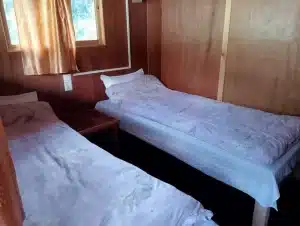
Teahouse accommodation
There are accommodation options everywhere.
Tourist towns like Namche offer the greatest variety, including five-star and basic hotels. But, there are basic teahouses and guesthouses on every stopover.
Here are three different types of Everest Base Camp Trek accommodations:
Teahouse Accommodation on EBC Route
Tea houses are small mountain hotels run by local families. In the Everest region, local Sherpas own these accommodations.
Teahouses are simple, but help you with both food and lodging problems. You can expect a small room or dormitory-style room with a clean wooden bed, blankets, pillow, and bedsheet. There’s also a common dining area with a fireplace.
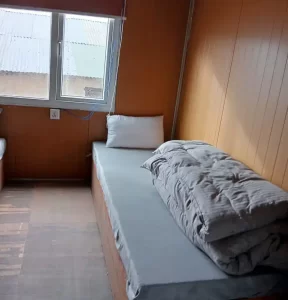
normal bedroom in teahouse
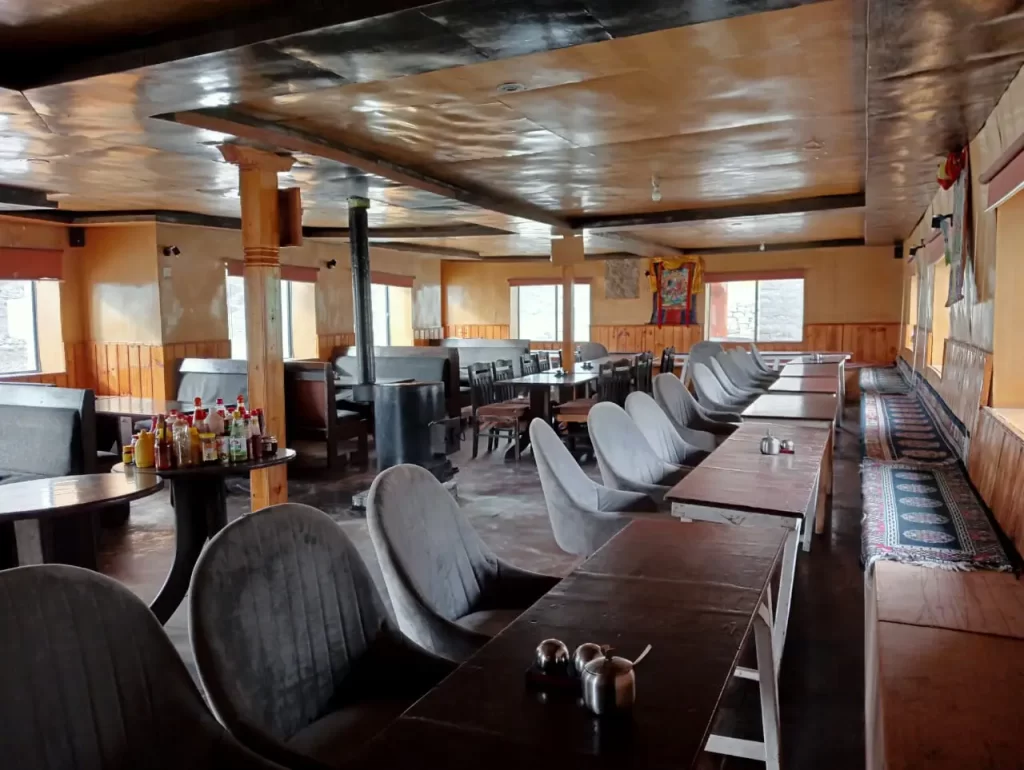
Common Dining Area
In lower elevations up to Dingboche (14,470 ft.), most tea houses are multi-story concrete buildings with private rooms and attached Western-style bathrooms.
But as you hike up, the accommodations become more basic. For instance, near the base camp in Gorakshep, there are dorm-styled shared rooms. There are common bathrooms and everyone has to wait for their turn to use it.
Facilities like hot showers, Wi-Fi, and charging devices cost additional charges everywhere.
Luxurious Hotels/Lodges on the Everest Base Camp Route
There are some local as well as popular hotel chains in the Everest region. They are quite expensive but they provide better services than the normal teahouses.
The rooms are luxurious and provide services like an attached bathroom, comfortable beds, electric blankets, hot water showers, exquisite furniture, room heaters, and free Wi-Fi services.
Hotel Everest View and Yeti Mountain Home are some examples of such Everest base camp trek accommodations.

Hotel room in Yeti Mountain Home
Camping
Nowadays, camping is not a very accessible way to sleep along the EBC trek route.
While camping, you spend the night in the tented camps. This is not as comfortable as the accommodation at teahouses or hotels; however, it offers better exposure to nature.
Since several teahouses are scattered throughout the Everest Base Camp route, this type of accommodation is not so popular. Also, camping on Everest is costly.
Camping is more common in remote and off-the-beaten trails like Dolpo and Dhaulagiri regions.
Factors to Consider When Selecting Accommodations on the EBC Trek
Now you are aware of every accommodation type available on the Mount Everest route.
There are many options for lodges, guesthouses, and hotels on Mount Everest trekking tours. As it’s a well-established pathway, the local government puts more emphasis on building a fully serviced teahouse at every stopover on the route.
As there are many, you might wonder how are you going to choose the best among them. These teahouses are located on the remote side and they don’t care about online presence. Thus, you will not find much information about them on the internet. So, is it harder to choose one of them? No, it’s not.
I will tell you why it’s easier to choose accommodation on the EBC Trek. Here are a few things to notice when choosing a good lodging facility.
Proximity to trekking routes and highlights
Always look for hotels or tea houses located closely along the trekking routes. It’s always better to stay close to important landmarks or viewpoints.
If you stay far from the trail, then you have to trek more to get to the path, which consumes more energy and time. So being closer to Mount Everest trail means less deviation from your main path, saving energy and time.
Comfort and amenities offered
Next, you need to consider the comfort and services offered by teahouses on the EBC route.
Always check whether the hotel or the teahouse you’re planning to stay in has electricity for charging devices, Wi-Fi, hot showers, and a restaurant or not. It’s also better to inquire about the cleanliness of the rooms and the toilets.
Some high-end hotels in the Everest region might even provide room heaters and electric blankets for extra comfort and warmth.
Luxurious stays vs budget-friendly accommodation on the Everest Base Camp Trek
Before choosing the right EBC Trek accommodation, you need to decide whether you want basic or luxury stays.
If you are clear about the options you are going to choose, then you can easily select your place of stay.
If you have a comfortable budget and want a comfortable place to sleep then, you can go for the guesthouses and hotel options.
If you are a budget traveler, then there are several budget-friendly teahouses along the route.
Even if you are the one who doesn’t want to compromise on quality, there are few high-end hotels along the route.
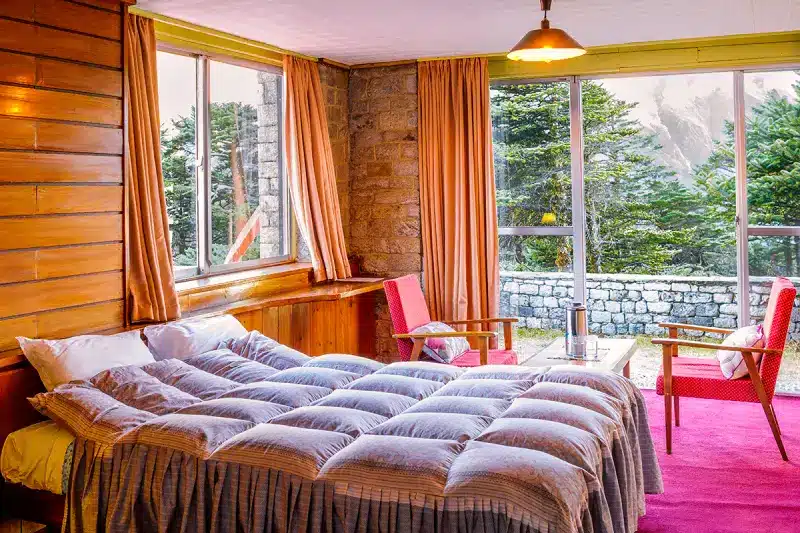
Room in Everest View Hotel
Understand the booking process for teahouses
If you are traveling to EBC during peak trekking season, then making reservations in advance is important.
If you want to stay at popular hotels or lodges, then you are required to make reservations.
Always make sure, you book your rooms prior. Otherwise, rooms might not be available.
If you are trekking with Heaven Himalaya, then you don’t need to worry about the accommodation part.
Altitude Acclimatization
When trekking to Everest Base Camp, you’re prone to altitude sickness. Thus, choose accommodation points at appropriate elevations for acclimatizations.
Check few others
Bathroom
It’s always better to look for bathrooms as it defines how much attention the owner pays to cleaning and sanitation. Clean and clear bathrooms and toilets are needed after a long walk during the day.
Common Dining Room with a Heater
Whatever the seasons is, it’s always cold in Mount Everest. Therefore, kindly look for a teahouse which has a common heater in the dining area. Most of the lodging facilities now have them but look if it runs or not.
Check if the attached bathrooms are available
Attached toilets are a modern-day necessity. Check if there’s any room with attached bathrooms.
Food Menu
After walking for 6 hours a day, all you need is good food to replenish the lost energy. Henceforth, look after the food menu to check if the available food is something you like to eat or your body is well adapted to.
Popular Accommodation Stops on the EBC Trek
The EBC trekking route is a well-established hiking trail and features a variety of tea houses. With the growth of the tourism business on this route, many well-featured tea houses have been built.
A general rule is that as you climb higher, the tea house gets more basic. Here are some famous stopovers along the Everest Base Camp route and the accommodations you can expect during your stay at these places:
Accommodation in Lukla
Lukla serves as the main gateway to the Everest region and is the starting point for your journey to Everest Base Camp. This vibrant town offers a variety of lodging options catering to the needs of trekkers.
The most common type of accommodation in Lukla is the teahouse. These cozy, locally run hotels offer lodging and meals, making them an excellent choice for trekkers. Teahouse rooms typically provide the basics: two single beds, shared bathrooms, and a communal dining area.
For those seeking a bit more comfort, Lukla also offers several mid-range lodges and guesthouses. These establishments feature private rooms with attached bathroom facilities.
Some may even provide additional amenities like hot showers, Wi-Fi, and charging facilities.
If you desire a more luxurious and comfortable stay, then Lukla offers several high-end hotels. These hotels offer superb comfort, excellent service, and a range of amenities. These hotels provide well-furnished rooms with the added luxury of room heaters.
Notable names among Lukla’s teahouses and luxurious hotels include Buddha Lodge, Lukla Numbur Hotel, Sherpa Lodge, Yeti Mountain Home, and Everest Summit Lodge.
Accommodation in Phakding
Phakding is a small, peaceful town where you’ll spend your first night during the Everest base camp trek. It’s a charming village with various options for places to stay. It lies next to the Dudh Koshi River, and you can find hotels and lodges on both sides of the river.
Most of these places offer basic lodging facilities. The rooms are simple and have minimal furniture. You’ll usually find twin-bed rooms. They provide wooden beds with blankets, pillows, and clean bedsheets for a good night’s sleep. The bathrooms are shared, and the toilets are the squat-style ones.
If you are willing to spend a bit more for extra comfort, there are some nicer hotels available. They cost a bit more for a night’s stay, but they offer more comfort. Most of these places have a common dining area where you can enjoy a hot meal.
In Phakding, you can stay at places like Sherpa Lodge, Panorama Lodge, and Yeti Mountain Home. These options cater to different preferences and budgets, making your first night on the Everest base camp trek comfortable and memorable.
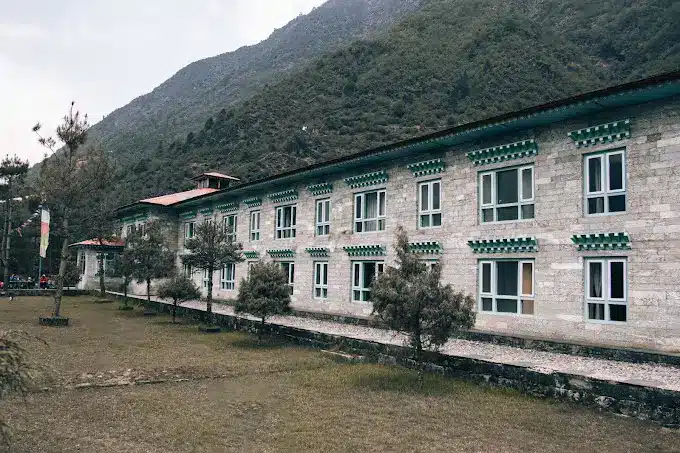
Luxury Hotel: Yeti Mountain Home
Accommodation in Namche Bazaar
Namche Bazaar offers a variety of accommodation options, catering to the diverse preferences and budgets of trekkers. During the trekking journey, it’s common for trekkers to spend at least two nights in Namche for acclimatization on the way up and one night on their descent. Only short Everest Base Camp treks have only one night’s stay in Namche.
The village is the biggest commercial hub and has a range of places to stay, from high-end hotels to mid-range options and basic tea houses. Depending on your budget and the service you desire, you can choose the accommodations in Namche.
Namche is home to the world’s highest-placed hotel, Hotel Everest View. This luxurious option promises a stunning Mt. Everest view from every room. Each room has spacious attached bathrooms, sitting areas, and balconies with amazing mountain views.
High-end hotels provide king-sized beds with comfortable soft mattresses, warm, clean blankets, and electric mats. For added luxury, you will get an electric blanket, a small room heater, a thermos, and free Wi-Fi throughout the hotel.
For those seeking mid-range accommodations, there are larger hotels in Namche that offer various room types, from basic to deluxe. These rooms come with attached bathrooms or shared toilet and shower facilities, accommodating different preferences.
Teahouses remain a popular choice for trekkers, even with the availability of high-end and mid-range options. These establishments offer twin-sharing rooms with wooden beds, pillows, and blankets.
Some of the teahouses, mid-range hotels, and luxury hotels in Namche include Hotel Namche, Hotel Khangri, Mountain Lodges of Nepal, Yeti Mountain Home, and Everest View Hotel.
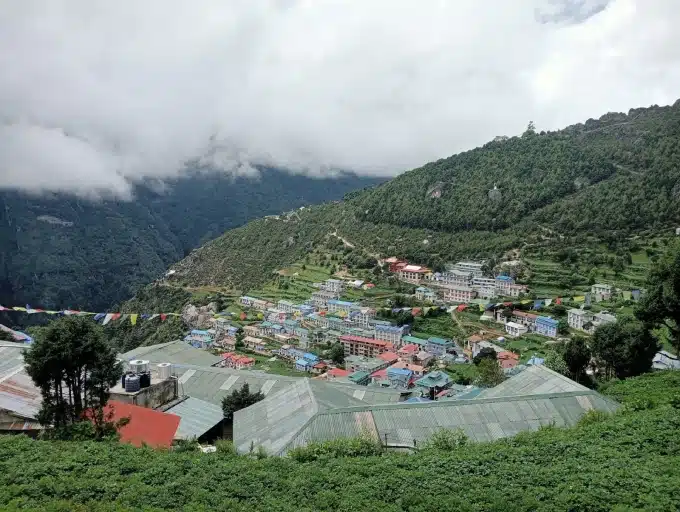
Namche Bazaar
Accommodation in Tengboche
Tengboche is well-known for its impressive Tengboche Monastery, the largest in the Khumbu region. From the top of the monastery, you can behold the splendid view of the mountains. During the EBC trek, many trekkers join the morning prayers at the monastery.
Compared to places like Namche and Lukla, accommodations in Tengboche are more basic, but they are still comfortable. Here, teahouses provide basic rooms with shared toilets and showers. You may have to pay for hot showers and device charging. While lodges in this area are a bit more comfortable than tea houses, there is a possibility of getting private rooms in lodges.
During the peak trekking seasons, Tengboche can be a bit crowded. Just above this village is Deboche, where you can find a few hotels. While the lodging options are comfortable, Tengboche does not have luxury hotels at the moment.
However, there are ongoing construction efforts, so we can anticipate the addition of more comfortable and higher-quality options for trekkers in the future.
Some well-known teahouses and lodges in the area include Tengboche Guesthouse, Deboche Lodge, Rivendell Lodge, Tashi Delek Lodge and Restaurants, and Hotel Himalaya.
Accommodation in Dingboche
Dingboche is another important acclimatization stop during the Everest base camp trek. Trekkers typically spend two nights here to help their bodies adjust to the thin air. However, at this high altitude, accommodation options are limited and quite basic. Operating teahouses in the challenging mountainous terrain above 4,000 meters is tough.
In Dingboche, you’ll find tea houses offering minimal facilities. Most rooms have common toilets and showers. Some newly built tea houses have rooms with attached toilets and bathrooms, but extra charges apply for services like hot showers, Wi-Fi, and device charging.
Likewise, during the busiest trekking seasons, almost every teahouse in Dingboche may be fully packed. This might mean sharing a room with family members or even sleeping in the dining hall. Don’t expect any luxury accommodations in Dingboche. Instead, while staying there, take the opportunity to experience the simple mountain lifestyle of the Sherpa community.
Some of the teahouses and lodges you can consider in Dingboche include Friendship Lodge, Dingboche Guest House, Good Day Lodge, and Island Peak View Lodge.
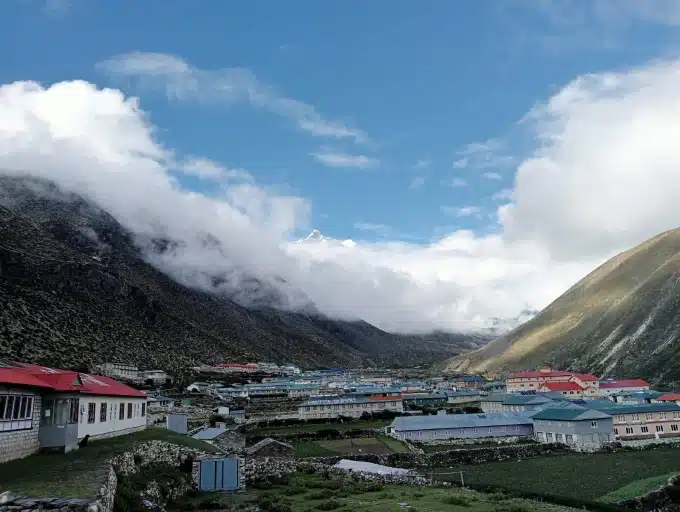
Dingboche Village
Accommodation in Lobuche
Lobuche is the second-last stop before you reach Everest Base Camp. Being so close to the base camp, the accommodation facilities become even more basic.
Similarly, the accommodations in Lobuche are quite basic due to the challenges of running teahouses in the high-altitude and rugged mountain environment. These teahouses have simple rooms, warm dining halls, and good food options.
Most of the tea houses have private bedrooms with twin beds and a common bathroom. There is minimal furniture, often just a table and dustbin. Many rooms may not even have a cloth hanger.
However, tea houses provide warm blankets and mattresses for a cozy sleep, but it’s highly recommended to bring a sleeping bag for extra warmth.
Due to restrictions in the national park, there are limited hotels in Lobuche. So, during the peak seasons, finding a room can be very challenging. Without booking, you might end up sleeping in the dining area.
Moreover, charging mobile devices and taking hot showers are costly in Lobuche. You’ll often find bucket showers as an option.
Some of the best hotels and teahouses in Lobuche include Oxygen Altitude Home, New EBC Guest House, Eco Lodge, National Park Hotel and Restaurant, Mother Earth House, and the Himalayan Eco Resort.
Accommodation in Gorak Shep
Gorak Shep serves as the last stop before reaching Everest Base Camp and Kala Patthar. It is a temporary settlement, and there are only a few hotels, with some of them not open year-round. Thus, securing accommodation in Gorak Shep is a crucial thing that shouldn’t be overlooked.
The Everest base camp trek accommodation in Gorak Shep has basic rooms with shared toilets. These rooms are very decent, with only beds. Although hotels offer a blanket and woolen bed sheets, it’s essential to bring a sleeping bag, as the rooms can get very cold. During busy periods, you are forced to stay in the dining area due to room shortages.
Charging facilities are usually available in the dining halls of the hotels. Keep in mind that prices for these services tend to be relatively high along the entire Everest base camp trek route.
Some of the hotels you can find in Gorak Shep village include Snow Land Highest, Himalayan Lodge, Yeti Lodge, and Buddha Lodge.
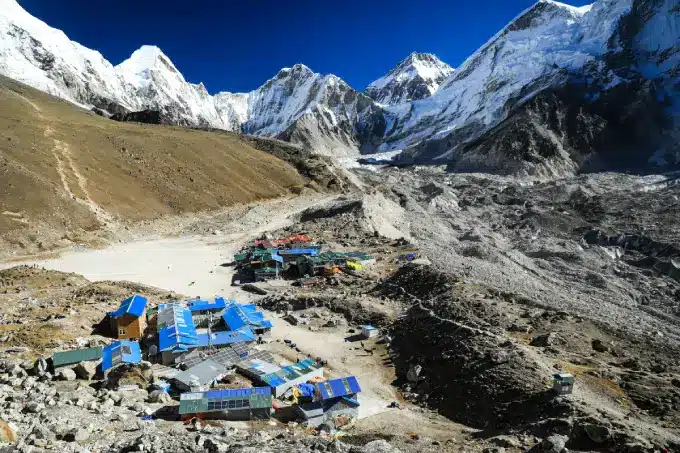
Accommodations in Gorakshep
Accommodation Costs on the Everest Base Camp Trek
During the Mount Everest trek, teahouse accommodations are a popular and affordable choice for trekkers. They are widely available throughout the region, providing convenient overnight options.
The price of basic EBC accommodations can vary depending on the location and level of services, ranging from USD 10 to 50 per night.
In the lower elevations, basic lodges and tea houses are more budget-friendly, with prices of around USD 10 per day. Rooms with attached bathrooms and hot shower facilities typically come at an additional cost.
For those seeking a luxury experience, staying in upscale hotels can cost around USD 150 to 300 per night, offering a five-star experience for a higher price.
What can you expect on teahouse accommodation on the EBC Trek?
When embarking on the Mount Everest trek, you can expect a Sherpa culture and warm hospitality. Tea houses, which are the most common form of accommodation along the trail, offer a comfortable place to rest after a long day of trekking.
Here’s what you can expect during your stay in a teahouse during the EBC trek:
Comfortable bedding facilities
Teahouses along the EBC route offer basic but comfortable accommodations. You can expect a private room or dormitory-style room with clean bedding and blankets to keep you warm. While amenities are basic, you’ll have everything you need for a good night’s sleep.

Typical guesthouse beds on Everest Base Camp Route
Hearty meals
Every Everest base camp tea house serves traditional and Western cuisine. They provide healthy meals to keep you energized during your trek. Dal Bhat (lentil soup and vegetable curry with rice), momo (dumplings), and noodles are common choices. You’ll also find Western dishes and a variety of hot and cold beverages to choose from.
Basic amenities
While facilities may be basic, teahouses offer essential amenities such as common toilets and showers with hot showers (usually for an additional fee). Electricity may be limited, so you have to pay a small fee to charge your electronic gadgets. Wi-Fi is often available for a fee and can be unreliable in remote areas.
Common dining area
In every teahouse in the Everest region, you’ll find a common dining area. It is a gathering place for trekkers from around the world. You’ll have the opportunity to meet fellow travelers, share stories, and make new friends. While having dinner or lunch, it’s a great way to bond with like-minded individuals.
The warm hospitality of the Sherpa people
Nepali people are well-known for their warm hospitality and friendliness. Teahouses along the EBC trek route are often run by local Sherpa people who take pride in welcoming trekkers. They will do their best to make you feel at home. They provide great insight into their local culture, traditions, and customs.
Extra Packing Tips for Accommodation Comfort
Here are some additional packing tips to make your stay in the Everest base camp tea house more comfortable:
Sleeping bag
A good-quality sleeping bag suitable for the expected weather is a must. Even though tea houses provide blankets, it might not be enough for cold temperatures at higher elevations. So, make sure your sleeping bag has the right temperature rating for the season and altitude of your trek.
Liners
You can bring a sleeping bag liner, as it adds warmth and cleanliness to your sleeping arrangement. These lightweight liners can be used in teahouse bedding and help keep your sleeping bag clean.
Travel pillow
Carry a portable, inflatable travel pillow for your comfort and quality of sleep. It provides support for your neck and head so that you can wake up refreshed.
Earplugs
EBC hotels can be busy, and sometimes the noise of the trekkers can disturb your sleep. Also, most tea houses’ rooms are small and have thinner walls. So, earplugs are an effective solution for peaceful nights.
Headlamp or flashlight
Teahouses may not always have reliable electricity, so a headlamp is handy for moving around at night, like going to the bathroom.
FAQs on Everest Base Camp Trek Accommodation
What extra amenities are available in the Everest region?
In the Everest region, you can access various additional amenities to enhance your trekking experience. Some extra amenities you might encounter are hot showers, electricity for charging devices, Wi-Fi hotspot services, electric blankets, etc. All these services are commonly found in teahouses and hotels, with some additional costs. Be aware that the prices tend to increase for these services as you approach the base camp.
Where do I stay on the Everest Base Camp Trek?
While trekking to EBC, you have a range of overnight stay options available. These options include basic teahouses, mid-range hotels, and even high-end luxury hotels and resorts along the route. However, as you ascend, the accommodation facilities become more basic, with fewer services. Among trekkers, teahouse accommodation is the most popular choice.
Is the Everest Base Camp Trek crowded?
Yes, the Everest base camp trek can get quite crowded, particularly during the peak trekking season in autumn and spring. Many trekkers from around the world are drawn to this iconic hiking trail. If you are seeking a more peaceful alternative, the Everest region also offers the Gokyo Lakes Trek, which is a less crowded option.
Do I need a sleeping bag for the Everest Base Camp Trek?
Yes, it is highly recommended to bring a sleeping bag for the Everest Base Camp trek. While tea houses provide blankets, they might not be sufficient, especially at higher altitudes that can be freezing.
Is there access to Wi-Fi during the Everest Base Camp Trek?
Wi-Fi availability during the Everest Base Camp Trek varies by location. Villages like Lukla and Namche offer Wi-Fi, but at higher altitudes, it may not be available or can be slow due to congestion. For better connectivity, consider using a SIM card with 3G or 4G networks, allowing you to stay connected throughout the trek.
Are there hot showers on the Everest Base Camp Trek?
Yes, hot showers are generally available at various points along the EBC trek. Most teahouses, especially those in the lower elevations, offer the option of hot showers for an additional fee.
However, as you ascend to higher altitudes, the availability of hot showers can become less reliable and more expensive. In more remote regions of the trek, the facilities are limited and only available at an increased cost.
Can I charge my electronic devices?
Yes, you can charge your electronic devices at teahouses and lodges along the EBC trek, but there may be a fee, and availability can vary. It’s important to note that electricity in these EBC hotels is not always reliable and is often generated from solar panels.
As a result, they may charge a small fee for device charging, and in cloudy or gloomy weather, electricity may not be available, making charging impossible. So, carrying a solar power bank or solar charger can be handy.
Is it possible to spend the night at Everest Base Camp?
Generally, in the standard Everest base camp trek itinerary, there is no overnight stay option at the base camp. But if you wish, we can arrange the sleeping arrangement for an additional cost. Also, kindly note that it is possible only during the climbing months, like March and April.
Are Everest base camp teahouses open year-round?
Yes, almost every teahouse, particularly at lower elevations along the EBC trail, is open year-round. However, at higher altitudes, some guesthouses might be closed during certain periods when the villagers migrate to the lower elevations to escape the extreme cold temperatures.
When can you trek to Everest Base Camp?
The Everest base camp trek is doable year-round. But the best time for the EBC trek is in spring and autumn when the weather is stable and the temperature is pleasant, perfect for trekking. During this time of the year, the visibility is also excellent, and there is a high chance of getting an unobstructed view of Mt. Everest.
Is it safe to trek to Everest Base Camp?
Trekking to Everest base camp is completely safe if you plan and prepare adequately. However, there are certain risks associated with high-altitude trekking, particularly the risk of altitude sickness. To mitigate this risk, you need to acclimatize well, stay hydrated, walk slowly, and follow the “climb high and sleep low” rule.
How are toilet facilities on the EBC trail?
Toilet facilities along the Everest base camp trail are generally available at every teahouse. The type of toilet may vary from place to place. Some teahouses have Western-style toilets with manual flushing systems, while others have traditional squat-style toilets with buckets and mugs for flushing. However, it’s important to note that teahouses typically do not provide toilet paper. You should bring your supplies if you require them during the trek.
Final Thoughts
In conclusion, whether you’re planning a budget or luxury trek to Everest Base Camp, you’ll find suitable accommodation according to your preferences. Teahouses are the most common and provide basic but comfortable lodging for EBC trekkers.
For those with a higher budget, mid-range or luxurious hotels are available in the Everest region. Regardless of choice, it’s important to book in advance during the peak trekking seasons, as the trail can get crowded and good accommodations fill up early.
Lastly, booking with us will ensure that you’ll secure the best accommodations, enhancing the comfort and uniqueness of your EBC trek. Your journey will be even more special and comfortable with our commitment to providing the best lodging options.
If you have any queries regarding available accommodations on the Everest base camp route then you can ask in the comments or contact us directly.

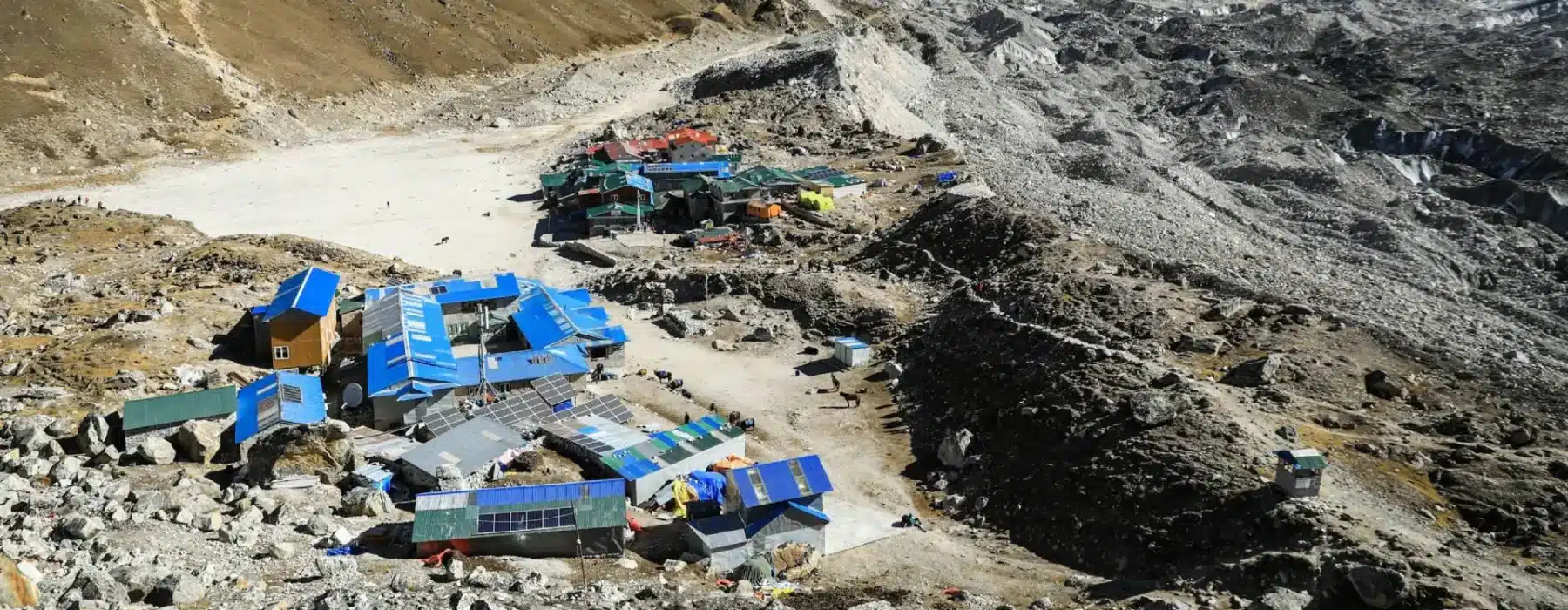

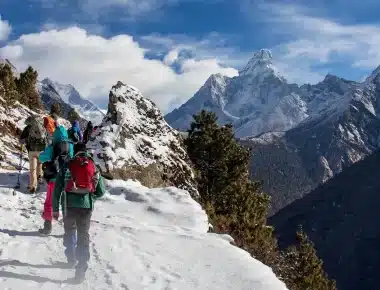
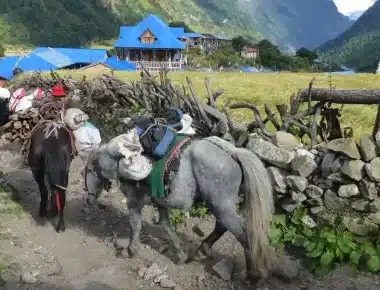
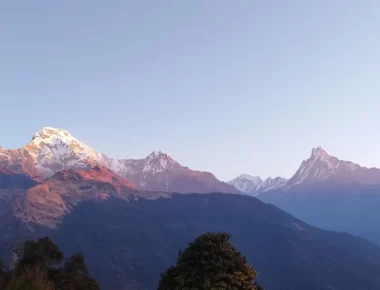


0 Comments